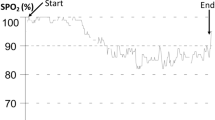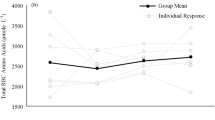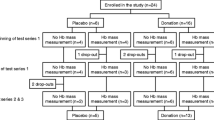Summary
The red cell population in peripheral venous blood was characterised in 7 young males before and up to 16 days after a 21.1 km road race.
There was a 1.9±2.4% (mean±SD) reduction in plasma volume immediately post race (p<0.05), an increase in serum osmolality from 277±4 mOsm·kg−1 to 291±14 mOsm·kg−1 (p<0.05) and a reduction in red cell water (64.4±0.3% to 63.4±0.4%,p<0.001). The latter was consistent with alterations in the manually derived MCV and MCHC values although the same Coulter derived values were unaltered. A concomitant increase in median red cell density in whole blood (1.1045±0.0009 g·ml−1 pre race to 1.1057±0.012 g·ml−1 immediate post race,p<0.05) was recorded by centrifugation through phthalate esters of different density. The changes in creatine content of the red cells suggested that during the race younger cells were released into the circulation but that 24 h to 72 h after the race the mean red cell age had increased. Similarly, fractionation of the red cells on discontinuous Percoll density gradients indicated that the cell population was significantly denser in all post race samples up to 72 h but had normalized by a 16 day sample; the osmotic fragility was similarly affected. The reticulocyte count did not significantly increase throughout the experiment but the mean red cell creatine content was elevated 16 days post exercise compared with the pre-race value suggesting a possible increase in erythropoiesis between 72 h and 16 days post race. The study shows that exercise of this type may induce a small reduction in mean red cell survival time but that this does not immediately change erythropoietic activity.
Similar content being viewed by others
References
Beutler E, West C, Blume K-G (1976) The removal of leukocytes and platelets from whole blood. J Lab Clin Med 88:328–333
Brodthagen UA, Hansen KN, Knudsen JB, Jordal R, Kristensen O, Pauler P-E (1985) Red cell 2,3-DPG, ATP, and mean cell volume in highly trained athletes. Eur J Appl Physiol 53:334–338
Chaplin H, Cassell M, Hanks GE (1961) The stability of the plasma hemoglobin level in the normal human subject. J Lab Clin Med 57:612–619
Clark MR, Shohet SB (1985) Red cell senescence. Clin Haematol 14:223–257
Dacie JV, Lewis SM (1984) ‘Practical Haematology’ 6th edn. Churchill Livingstone, London
Anon D, Marikovsky Y (1964) Determination of density distribution of red cell population. J Lab Clin Med 64:668–674
Davidson RJL (1969) March or exertional haemoglobinuria. Semin Haematol 6:150–161
Davidson RJL, Robertson JD, Galea G, Maughan RJ (1987) Haematological changes associated with marathon running. Int J Sports Med 8:19–25
Dill DB, Costill DL (1974) Calculation of percentage change in volumes of blood, plasma and red cells in dehydration. J Appl Physiol 37:247–248
Ebert RV, Stead EA (1941) Demonstration that in normal man no reserves of blood are mobilized by exercise, epinephrine and hemorrhage. Am J Med Sci 201:655–664
Fehr J, Knob M (1979) Comparison of red cell creatine level and reticulocyte count in appraising the severity of hemolytic processes. Blood 53:966–976
Freireich EJ, Ross JF, Bayles TB, Emerson CP, Finch SC, MacDonald C (1957) Radioactive iron metabolism and erythrocyte survival studies of the mechanism of the anemia associated with rheumatoid arthritis. J Clin Invest 26:1043–1058
Galea G, Davidson RJL (1985) Haemorheology of marathon running. Int J Sports Med 6:136–138
Hales JRS, Stephens FRN, Fawcett AA, Westerman RA, Vaughan JD, Richards DAB, Richards CRB (1986) Lowered skin blood flow and erythrocyte sphering in collapsed fun-runners. Lancet I:1495–1496
Janson G, Hepkema BG, van der Vegt SGL, Staal GE (1986) Glycolytic activity in human red cell populations separated by a combination of density and counterflow centrifugation. Evidence for an improved separation of red cells according to age. Scand J Haematol 37:189–195
Keys A, Taylor H (1935) The behaviour of the plasma colloids in recovery from severe work and the question as to the permeability of the capillaries to proteins. J Biol Chem 109:55–67
Li PK, Lee JT, Li C-S, Deshpande G (1982) Improved method for determining erythrocyte creatine by the diacyl-alphanaphthol reaction: elimination of endogenous glutathione interference. Clin Chem 28:92–96
Mairbäurl H, Humpeler E, Schwaberger G, Pessenhofer H (1983) Training-dependent changes of red cell density and erythrocytic oxygen transport. J Appl Physiol 55:1403–1407
Marks PA, Johnson AB (1958) Relationship between the age of human erythrocytes and their osmotic resistance: a basis for separating young and old erythrocytes. J Clin Invest 37:1542–1548
Maughan RJ, Whiting PH, Davidson RJL (1985) Estimation of plasma volume changes during marathon running. Br J Sports Med 19:138–141
Mohandas N, Clark MR, Kissinger S, Bayer C, Shohet SB (1980) Inaccuracies associated with the automated measurement of mean cell hemoglobin concentration in dehydrated cells. Blood 56:125–128
Persson SGB, Ekman L, Lydin G, Tufresson G (1973) Circulatory effect of splenectomy in the horse. 1. Effect on red cell distribution and variability of haematocrit in the peripheral blood. Zentralbl Veterinarmed [A] 20:441–455
Piomelli S, Luriinsky G, Wasserman LR (1967) The mechanism of red cell aging. I. Relationship between cell age and specific gravity evaluated by ultracentrifugation in a discontinuous density gradient. J Lab Clin Med 69:659–674
Platt OS, Lux SE, Nathan DG (1981) Exercise-induced hemolysis in xerocytosis. J Clin Invest 68:631–638
Reinhart WM, Chein S (1985) Stomatocytic transformation of red cells after marathon running. Am J Haematol 19:201–204
Reinhart WH, Stäubli M, Werker Straub P (1983) Impaired red cell filterability with elimination of old red cells during a 100-km race. J Appl Physiol 54:827–830
Rennie CM, Thompson S, Parker AC, Maddy A (1979) Human erythrocyte fractionation in “Percoll” density gradients. Clin Chim Acta 98:119–125
Stäubli M, Roessler B (1986) The mean red cell volume in long distance runners. Eur J Appl Physiol 55:49–53
Steenkamp I, Fuller C, Graves J, Noakes TD, Jacobs P (1986) Marathon running fails to influence RBC survival rates in iron-replete women. Physic Sports Med 14:89–95
Tillmann W, Levin C, Prindull G, Schroter W (1980) Rheological properties of young and aged human erythrocytes. Klin Wochenschr 58:569–574
Author information
Authors and Affiliations
Rights and permissions
About this article
Cite this article
Robertson, J.D., Maughan, R.J. & Davidson, R.J.L. Changes in red cell density and related indices in response to distance running. Europ. J. Appl. Physiol. 57, 264–269 (1988). https://doi.org/10.1007/BF00640674
Accepted:
Issue Date:
DOI: https://doi.org/10.1007/BF00640674




